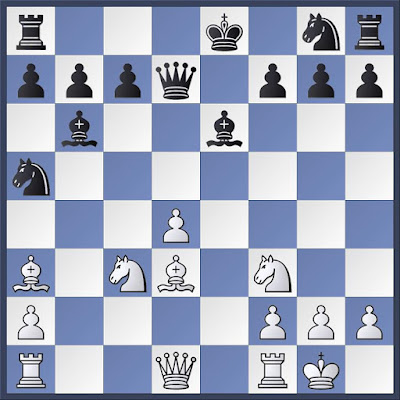My exercise set for the Knight Award has this position.
White to move
It is the exercise that my students find most difficult among the dozen in that set. The position arose in a game Paul Morphy played against his father when he was twelve years old.
An earlier position from this game appears as the third position in Thomas Engqvist, 300 Most Important Chess Positions (2018).
White to move
In the game, Paul Morphy's father, Alonzo, made several errors. Maybe he was not a very strong chess player. Maybe he sought to help build his son's confidence. Young Paul's moves are not in every case the first choice of today's engines, but his overall play demonstrates that already at the age of twelve, he understood the importance of rapid mobilization of his pieces and was not afraid to sacrifice material to exploit a vulnerable king.
Morphy,Paul C -- Morphy,Alonzo [C51]
New Orleans, 1849
1.e4 e5 2.Nf3 Nc6 3.Bc4 Bc5 4.b4 Bxb4 5.c3 Bc5 6.d4 exd4 7.cxd4
7.0–0 became a common reply in the 1860s. Both moves score well for White.
7...Bb6
7...Bb4+ is possible
8.0–0
Black to move
8...Na5
The elder Morphy neglects development, but as his son is usually credited with discovering the importance of development, our judgement should not be too harsh.
8...d6 would have been better.
9.Bd3 d5
Opening the e-file cannot be good for Black. The king's vulnerability will create the conditions for young Paul to show the skills that would become his signature.
9...Ne7;
9...d6
10.exd5 Qxd5
Father seems determined to help his son.
10...Ne7 11.Ba3 0–0 12.Qc2
11.Ba3 Be6 12.Nc3 Qd7
See Engqvist's position above.
13.d5!
Morphy understood that material does not matter when Black's king is vulnerable.
13... Bxd5
13...0–0–0 14.Qc2 (14.dxe6 Qxd3 15.exf7 Nf6 16.Be7)
14.Nxd5
My main line while looking at the position in Engqvist's book was 14.Bb5 c6 15.Re1+ Be6. I had not yet recognized the game as the source for my exercise.
14...Qxd5
White to move
15.Bb5+
Engines like 15.Re1+ Kd8 16.Be4 Qd7 (16...Nf6 avoids checkmate) 17.Qxd7+ Kxd7 18.Rad1+ Kc8 19.Bf5+ Kb8 20.Re8#
15...Qxb5 16.Re1+ Ne7 17.Rb1
Much better is 17.Rxe7+ Kf8 18.Ne5.
17...Qa6
This move offers White a forced checkmate.
17...Qd7 18.Rxe7+ Qxe7 19.Bxe7 Kxe7 White still has a decisive edge, but has much work remaining after his relatively weak move 17.
White to move
18.Rxe7+ Kf8 19.Qd5
There is a faster checkmate, but it is hard to fault Morphy for pursuing a checkmate in two that can be delayed through spite checks.
19.Rxf7+ Kxf7 20.Qd7+ Kf6 21.Be7+ Kg6 22.Qe6+ Kh5 23.g4#
19...Qc4
See my position for the Knight Award at the top of this post.
19...Bxf2+ delays the end with spite checks.
20.Rxf7+ Kg8 21.Rf8# 1–0
I beat my dad when I played him at age fifteen, but my play lacked the sort of combinations that Morphy displayed. No record was made of the game (see "My First Chess Book").



















No comments:
Post a Comment